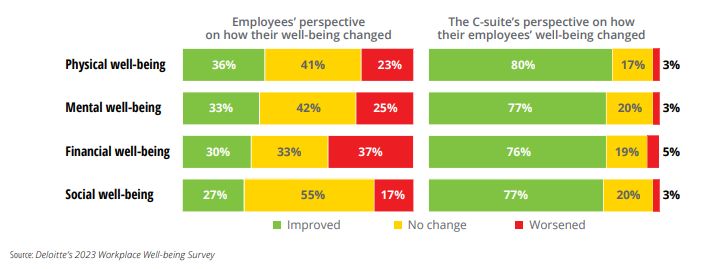Conflicting data:
A recent Deloitte workplace well-being survey has revealed a puzzling gap in how employees and executives see well-being. According to the results of this study, employees feel a standstill or decline, while executives believe they’ve boosted well-being. Let’s unpack what might be at the core of these diverging perspectives and figure out how to bring back genuine enthusiasm in the workplace.

Possible reasons to help us understand why the well-being data differs between these two groups:
Executive Toughness:
C-suites have lower well-being needs. They thrive in stressful & difficult work environments. This is what got them to the top. Maybe they assume everyone’s as tough as they are, seeing stress as a ladder to success without realizing its toll on others.
Data Over People:
C-suites look at the numbers and assume the money they are spending must be having an impact. According to the same Deloitte report, large organizations spend an average of $10.5 million yearly on well-being programs. How much more is needed?
Chasing an Elusive Well-Being:
Well-being might be a moving target. The more we have it, the more we want it. With rising expectations, there is never a clear finish line.
Personal Well-Being Choice:
Well-being is an internal state, a choice of how we show up daily. The more we focus on the good that is already there (vs what is lacking), the more we will cultivate a sense of well-being within. Outsourcing it to the employer will not work.
Well-Doing Over Well-Being:
Employees don’t really want more well-being. It temporarily fills a void but what they really want is “well-doing”. The yearning is for meaningful work, ownership, purpose. They want to see the impact of their work, make a difference, feel a sense of pride and have fun doing it. They don’t actually mind working long hours and enduring stressful situations. They are happy to give up the luxurious office environments, and perhaps even some pay, as long as the work is meaningful and brings the best out in them.
Additional Considerations:
How do we act on this data to reignite enthusiasm in the workplace?:
- Focus on meaningful Work: Connect tasks to a bigger purpose so employees feel the impact of their efforts.
- Delegate ownership: Let employees take charge of projects, boosting pride and accomplishment.
- Positive Culture: Build a culture of positivity, teamwork, and growth.
- Trust when and how people deliver their work: Focus on results and give people the freedom to choose how they offer their best work.
- Open lines of communication: Have direct conversations with executives to address data points like these to help bridge the gap between the rest of the organization between executives and the workforce.
Conclusion:
Fixing the well-being gap means recognizing varied needs, building a positive culture, and prioritizing communication. It’s about redefining success for individual and team happiness. Let’s bring back that workplace mojo!
FAQ
Why is there a gap in how employees and executives perceive well-being in the workplace?
Executives perceive stress as a success catalyst, assuming shared resilience. Investments in well-being focus too much on short-term perks vs the drivers of meaningful work.
How can organizations reignite enthusiasm for well-being in the workplace?
To revive enthusiasm: align tasks with purpose, give ownership for pride, foster a positive culture, prioritize teamwork and flexibility, and ensure open communication.
Are employees seeking more than traditional well-being perks?
Employees seek more than perks; it’s about “well-doing” – valuing meaningful impact over well-being goodies. They crave purpose, ownership, and pride in work.

